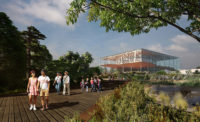The saying goes that a rising tide lifts all boats, but what happens to national monuments, environmental landmarks, and other fixed elements of landscape when the waters rise and refuse to recede? That question is at the crux of the Tidal Basin Ideas Lab, which showcases the work of five firms, commissioned by the National Park Service, the National Trust for Historic Preservation, and Trust for the National Mall. Those ideas are on display in a digital exhibition launched this morning that explores possible scenarios and solutions for Washington, D.C.’s Tidal Basin.
Located just south of the National Mall, between the Potomac River and the Washington Channel—one of which serves as an inlet, the other as an outlet—the 107-acre Tidal Basin is a national landmark ringed with presidential monuments as well as cherry trees presented to the U.S. by Japan. Twice daily, brackish waters surge above constructed edges to threaten both trees and memorials with inundation; as extreme weather events become more frequent and water levels rise, the Tidal Basin is at risk for complete submersion.
Recognizing the national and international importance of this site, the agencies involved solicited input from civic partner Skidmore, Owings & Merrill (SOM) for five landscape architecture firms—DLANDstudio, GGN, Hood Design Studio, James Corner Field Operations, and Reed Hilderbrand—to analyze the situation and respond to it. Their resulting conversations shaped the broad range of perspectives, scenarios, and proposals that comprise the virtual exhibition curated by Donald Albrecht and Thomas Mellins. The digital format, Mellins explains, “allows the site’s sponsors to get a virtually unlimited level of visitor input, and to raise awareness of the challenges facing the Tidal Basin and the opportunities to renew and restore it.”
Using the format of a four-part graphic novella, Walter Hood (founder of Oakland-based Hood Design Studio) speculates on possible futures for the Tidal Basin, including one where an embrace rather than rejection of water produces wetland “hush harbors”—named after places where enslaved people in the South found safe haven from plantation owners. Analysis of embedded histories in the site brings about a new, multi-layered story for the future. “This could be a place that could become a model of advocacy for lost narratives,” Hood says in an exhibition video. “[It could be] a model for the nation to think about what real democratic space is.”
Among the more radical proposals is one by DLANDstudio to extend the National Mall via a jetty to the west of the Lincoln Memorial, and to relocate the Martin Luther King, Jr. Memorial upon this new land. Much of the area surrounding the Tidal Basin is already built on fill; this proposal seizes upon that notion, deploying the jetty as a means of catalyzing the flows of the Potomac to deposit silt that would bolster the Tidal Basin against flooding. “By creating a formal move of this jetty, we’re creating an eddy that can become a protective landscape for the Mall,” DLAND founder Susannah Drake says. “It utilizes a lot of natural systems to be an engine for the creation of the future site.”
James Corner Field Operations developed three scenarios that might play out according to amount of effort involved. The minimal-effort scheme proposes curating entropy by giving the whole of the Tidal Basin over to nature. Although this would effectively mean sacrificing low-lying memorials to rising river levels, a new, elevated walkway would offer a perspective on monuments taken over by age and decay. The most hands-on (and costly) approach involves reimagining the Tidal Basin as an archipelago, elevating memorial structures above flood levels but also monumentalizing nature. “You can see how the three scenarios are designed to raise different issues and different possibilities,” Corner says, who seeks “to provoke critical thought into how we as a society might proceed with these sorts of issues.”
Recognizing that sea level rise will be gradual, GGN suggests near-term repair of failing floodgates and sea-wall infrastructure that would buy time for a phased approach to ecological implementation over the next century. It suggests converting the Tidal Basin’s edges to marshland and floodplain forests replete with Liriodendron tulipifera (tulip trees). “It’s really the evolution of the space that’s important,” Kathryn Gustafson, founding principal of GGN, says. “That evolution is not so much imposed as just taking advantage of a situation to make something more positive.”
Reed Hilderbrand’s proposal preserves the essential qualities of the Tidal Basin while protecting its assets from rising waters, primarily by creating higher ground and migrating cherry trees to it to retain the symbolic landscape. Edges along the Potomac are likewise filled to harden them as stronger buffers against degradation and subsidence. A landform bulwark protects the formal rigor of the National Mall, and new bridges and pathways connect the city to the Basin
The Tidal Basin Ideas Lab affords opportunities for broad overviews of the problems facing the landscape as well as deep dives into the proposed solutions through renderings and videos. Presented digitally (as Covid-19 has made indoor public gatherings unwise), the exhibition expects to reach an expanded audience well beyond that which might be accomplished in a physical space, which the curators hope will foster continued dialogue on preserving the site’s history while preparing for its future.












Post a comment to this article
Report Abusive Comment